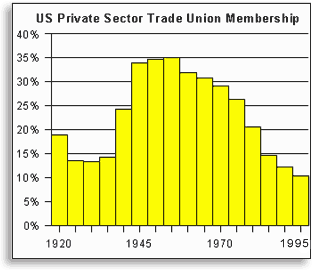Craft unions are the successors to the craft guilds of the Middle Ages. The first unions of the modern era were craft unions, local in scope and encompassing small numbers of workers. Craft unions have historically been more conservative in their outlook, both politically and socially, than the industrial unions. Craft, or trade, unions are often cited as examples of horizontal organization, meaning they seek to include the entire population of similarly skilled workers. Conversely, industrial unions, which are often cited as examples of vertical organization, seek to include the broad population of workers within an industry, skilled or unskilled.
Craft guilds have existed since colonial times. The first genuine craft union in the United States consisted of shoemakers in Philadelphia. Early unions that have survived to the present day include the International Typographical Union, founded in 1852, and the National Union of Iron Molders, founded in 1859. Union activity gained further momentum following the Civil War.
 The first major challenge to the craft unions’ dominance was the Knights of Labor (K.O.L.). The K.O.L. favored community-based unions that included more than just skilled workers and promoted a progressive social agenda as well. They lost influence in the 1880s due to their failure in the Missouri Pacific strike in 1886 and the disastrous Haymarket Square Riot of the same year. In the public’s mind, the eight-hour work day and other demands by the K.O.L. had become radical ideas; to many, the terms "unionism" and Anarchism were synonymous. The K.O.L. also suffered from mismanagement and internal divisions, especially the longstanding strife between the skilled and unskilled worker members. Finally, the rise of the American Federation of Labor (A.F. of L.) that same year offered an alternative that rejected radicalism and organized its members along craft lines.
Although the A.F. of L. was committed in principle to the interests of all workers, by their nature craft unions favored skilled workers, who tended to be white and male. At first, blacks were openly encouraged to join the A.F. of L., until it was later seen that their explicit stand on race issues hampered the organization’s expansion. Thereafter, as long as a union did not include anything in its constitution regarding the exclusion of members because of race, that union was welcome to join the A.F. of L. Few women were members of craft unions because they were mostly confined to industrial and domestic positions, which were not organized.
In the 20th century, the rise of industrial unions presented another challenge. Craft unions favored the interests of skilled workers, while having little concern for the unskilled masses. Industrial unions promoted the economic well-being of all workers in each of the companies they organized. Tensions between those two approaches led to the creation and separation of the Congress of Industrial Organizations (C.I.O.) from the A.F. of L. in 1938 and a nearly two-decade rift in the labor movement.
Modern craft unions continue the tradition of apprenticeship, with full union membership carrying an implicit stamp of approval. Craft unions require their members to maintain and improve their skills, which provides a basis for the union scale of wages.
The first major challenge to the craft unions’ dominance was the Knights of Labor (K.O.L.). The K.O.L. favored community-based unions that included more than just skilled workers and promoted a progressive social agenda as well. They lost influence in the 1880s due to their failure in the Missouri Pacific strike in 1886 and the disastrous Haymarket Square Riot of the same year. In the public’s mind, the eight-hour work day and other demands by the K.O.L. had become radical ideas; to many, the terms "unionism" and Anarchism were synonymous. The K.O.L. also suffered from mismanagement and internal divisions, especially the longstanding strife between the skilled and unskilled worker members. Finally, the rise of the American Federation of Labor (A.F. of L.) that same year offered an alternative that rejected radicalism and organized its members along craft lines.
Although the A.F. of L. was committed in principle to the interests of all workers, by their nature craft unions favored skilled workers, who tended to be white and male. At first, blacks were openly encouraged to join the A.F. of L., until it was later seen that their explicit stand on race issues hampered the organization’s expansion. Thereafter, as long as a union did not include anything in its constitution regarding the exclusion of members because of race, that union was welcome to join the A.F. of L. Few women were members of craft unions because they were mostly confined to industrial and domestic positions, which were not organized.
In the 20th century, the rise of industrial unions presented another challenge. Craft unions favored the interests of skilled workers, while having little concern for the unskilled masses. Industrial unions promoted the economic well-being of all workers in each of the companies they organized. Tensions between those two approaches led to the creation and separation of the Congress of Industrial Organizations (C.I.O.) from the A.F. of L. in 1938 and a nearly two-decade rift in the labor movement.
Modern craft unions continue the tradition of apprenticeship, with full union membership carrying an implicit stamp of approval. Craft unions require their members to maintain and improve their skills, which provides a basis for the union scale of wages.